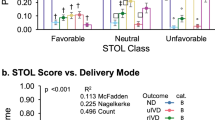Abstract
Objective:
To evaluate the diagnostic impact of limited obstetric ultrasound (US) in identifying high-risk pregnancies when used as a screening tool by midwives in rural Uganda.
Study Design:
This was an institutional review board-approved prospective study of expecting mothers in rural Uganda who underwent clinical and US exams as part of their standard antenatal care visit in a local health center in the Isingiro district of Uganda. The midwives documented clinical impressions before performing a limited obstetric US on the same patient. The clinical findings were then compared with the subsequent US findings to determine the diagnostic impact. The midwives were US-naive before participating in the 6-week training course for limited obstetric US.
Result:
Midwife-performed screening obstetric US altered the clinical diagnosis in up to 12% clinical encounters. This diagnostic impact is less (6.7 to 7.4%) if the early third trimester diagnosis of malpresentation is excluded. The quality assurance review of midwives’ imaging demonstrated 100% sensitivity and specificity in the diagnosing gestational number, and 90% sensitivity and 96% specificity in the diagnosis of fetal presentation.
Conclusion:
Limited, screening obstetric US performed by midwives with focused, obstetric US training demonstrates the diagnostic impact for identifying conditions associated with high-risk pregnancies in 6.7 to 12% of patients screened. The limited obstetric US improved diagnosis of early pregnancy complication as well as later gestation twins and malpresentation. Midwives who have undergone focused 6-week limited obstetric US training proved capable of diagnosing twins and fetal presentation with high sensitivity and specificity.
This is a preview of subscription content, access via your institution
Access options
Subscribe to this journal
Receive 12 print issues and online access
$259.00 per year
only $21.58 per issue
Buy this article
- Purchase on Springer Link
- Instant access to full article PDF
Prices may be subject to local taxes which are calculated during checkout
Similar content being viewed by others
References
UN. Assessing Progress in Africa toward the Millennium Development Goals. United Nations, New York, 2012.
Adler D, Mgalula K, Price D, Taylor O . Introduction of a portable ultrasound unit into the health services of the Lugufu refugee camp, Kigoma District, Tanzania. Int J Emerg Med 2008; 1: 261–266.
Bussmann H, Koen E, Arhin-Tenkorang D, Munyadzwe G, Troeger J . Feasibility of an ultrasound service on district health care level in Botswana. Trop Med Int Health 2001; 6: 1023–1031.
Doehring-Schwerdtfeger E, Abdel-Rahim IM, Dittrich M, Mohamed-Ali Q, Franke D, Kardorff R et al. Ultrasonography as a diagnostic aid for a district hospital in the tropics. Am J Trop Med Hyg 1992; 46: 727.
Hoyer PF, Weber M . Ultrasound in developing world. Lancet 1997; 350: 1330.
Shah S, Noble VE, Umulisa I, Dushimiyimana JMV, Bukhman G, Mukherjee J et al. Development of an ultrasound training curriculum in a limited resource international setting: successes and challenges of ultrasound training in rural Rwanda. Int J Emerg Med 2008; 1: 193–196.
Spencer JK, Adler RS . Utility of portable ultrasound in a community in Ghana. J Ultrasound Med 2008; 27: 1735–1743.
Stein W, Katunda I, Butoto C . A two-level ultrasonographic service in a maternity care unit of a rural district hospital in Tanzania. Trop Doct 2008; 38: 125–126.
Steinmetz JP, Berger JP . Ultrasonography as an aid to diagnosis and treatment in a rural African hospital: a prospective study of 1,119 cases. Am J Trop Med Hyg 1999; 60: 119–123.
Kimberly HH, Murray A, Mennicke M, Liteplo A, Lew J, Bohan JS et al. Focused Maternal Ultrasound by Midwives in Rural Zambia. Ultrasound Med Biol 2010; 36: 1267–1272.
Kotlyar S, Moore C . Assessing the utility of ultrasound in Liberia. J Emerg Trauma Shock 2008; 1: 10.
Shah SP, Epino H, Bukhman G, Umulisa I, Dushimiyimana J, Reichman A et al. Impact of the introduction of ultrasound services in a limited resource setting: rural Rwanda 2008. BMC Int Health Hum Rights 2009; 9: 4.
Fox AJS, Chapman MG . Longitudinal ultrasound assessment of fetal presentation: A review of 1010 consecutive cases. Aust N Z J Obstet Gynaecol 2006; 46: 341–344.
Osmundson SS, Wong AE, Gerber SE . Second-trimester placental location and postpartum hemorrhage. J Ultrasound Med 2013; 32: 631–636.
Acknowledgements
This study is supported through grants from the GE Foundation, the University of Washington Radiology Health Services Research Seed Grant Program and Seattle International Foundation. We also thank Millenium Village Project in Isingiro, Uganda for their generous inclusion and support of our work within their healthcare facilities.
Funding for this project provided by: GE Foundation University of Washington Radiology Health Services Research Seed Grant Program Seattle International Foundation.
Author information
Authors and Affiliations
Corresponding author
Ethics declarations
Competing interests
The authors declare no conflict of interest.
Rights and permissions
About this article
Cite this article
Swanson, J., Kawooya, M., Swanson, D. et al. The diagnostic impact of limited, screening obstetric ultrasound when performed by midwives in rural Uganda. J Perinatol 34, 508–512 (2014). https://doi.org/10.1038/jp.2014.54
Received:
Revised:
Accepted:
Published:
Issue Date:
DOI: https://doi.org/10.1038/jp.2014.54
This article is cited by
-
Impact of point-of-care ultrasound use on patient referral decisions in rural Kenya: a mixed methods study
BMC Health Services Research (2024)
-
The training of midwives to perform obstetric ultrasound scan in Africa for task shifting and extension of scope of practice: a scoping review
BMC Medical Education (2023)
-
Experiences of midwives on Vscan limited obstetric ultrasound use: a qualitative exploratory study
BMC Pregnancy and Childbirth (2022)
-
Contribution of portable obstetric ultrasound service innovation in averting maternal and neonatal morbidities and mortalities at semi-urban health centers of Ethiopia: a retrospective facility-based study
BMC Pregnancy and Childbirth (2022)
-
A mobile-optimized artificial intelligence system for gestational age and fetal malpresentation assessment
Communications Medicine (2022)



